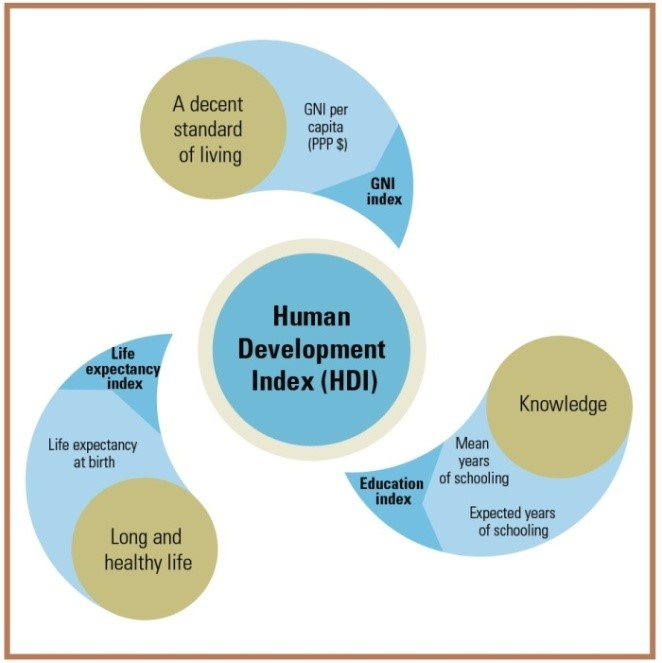Human Development Index
This article is based on “Three Decades of HDI” which was published in The Economic & Political Weekly on 02/01/2021. It talks about India's dismal performance in the Human Development Index.
The Human Development Index (HDI), which combines indicators of life expectancy, education or access to knowledge and income or standard of living, captures the level and changes to the quality of life.
The index is the making of two acclaimed economists from Pakistan and India, namely Mahbub ul Haq and Amartya Sen. It was initially launched as an alternative measure to the gross domestic product, as it stresses the centrality of human development in the growth process.
India has done a seemingly great job in multiplying it’s economy many folds, but progress on the HDI front has not been very appealing. The last three decades HDI’s data indicate that India has raised its HDI score at an annual average rate of mere 1.42%.
Therefore, if India has to realise it’s the aspiration of becoming a superpower, it must invest to reduce the burden of social and economic disadvantage to vulnerable sections of its population.
Progress Made by India
- As the UNDP’s HDR Report 2019 notes, India’s gross national income per capita has more than doubled since 2005, and the number of “multidimensionally poor” people fell by more than 271 million in the decade since 2005-06.
- Additionally, inequalities in “basic areas” of human development have reduced. For instance, historically marginalised groups are catching up with the rest of the population in terms of educational attainment.
Reasons For India’s Underperformance on HDI
The 2019 HDI ranks India with a per capita income of $6,681 in the 131st position, which is a notch lower than its 130th rank in 2018. The malefic effects of deep-rooted societal and economic disadvantages account for a low rank for an economy that is in the global top 6 by size. Following factors can be dubbed as reasons for India’s dismal performance in HDI:
- Increasing Income Inequalities: Income inequalities amplify failings on other HDI indices of human development. Intergenerational income mobility is lower in countries with high-income inequality.
- It manifests at birth and determines access to quality healthcare, education, and opportunities.
- Further, there is an increasing trend in income inequality. In India, the income growth of the bottom 40% between 2000 and 2018 (58%) was significantly below the average income growth for the entire population (122%).
- Gender Inequality: Numbers show female per capita income in India was only 21.8% of that of males, while it was more than double at 49% in other developing countries.
- The meagre per capita income of females in India is mainly because of their exclusion from the labour force.
- Only 20.5% of the women in the working-age group were in the labour force, pointing to its dismal Female Labour Force Participation Rate (LFPR).
- Cumulative Impact: The cumulative impact of these factors spills over across generations. It is this intergenerational cycle which denies opportunities to those at the bottom of the pyramid.
Way Forward
- Fair Income Distribution: While the size of economic resources is a key factor affecting human development, the distribution and allocation of these resources also play a major role in determining the level of human development.
- Many global case studies show that high growth accompanied by more effective income distribution can help enhance human development, even with moderate social expenditures.
- For Example, South Korea and Taiwan improved income distribution through early land reforms.
- Investing in Social Infrastructure: Universalisation of education and health care could have pulled deprived sections out of the poverty trap.
- Sustaining and improving the quality of life will also depend on policies crafted to handle major emerging challenges such as urbanisation, the housing deficit, access to power, water, education and health care.
- Streamlining of the Finances: Streamlining the traditional approach of generating new sources of revenue generation, steps like rationalised targeting of subsidies, judicious use of revenues meant for social sector development etc will probably meet the financial requirements needed for improving HDI.
- Good Governance Reforms: Effective performance evaluation of the projects and activities engaged in the social sector development through innovative methods like outcome budgeting, social auditing and participatory democracy has been known to yield positive results.
- Gender Empowerment: Government should invest in Gender equality and women’s empowerment, as they are integral to human development.
Conclusion
India’s HDI scores can be substantially enhanced if a politically committed government rolls out inclusive policies that strengthen public health, education and nutrition, and end gender discrimination to usher in a more egalitarian order.
|
Drishti Mains Question Strengthening public health, education and nutrition, and ending gender discrimination will usher a more egalitarian order. Comment. |

